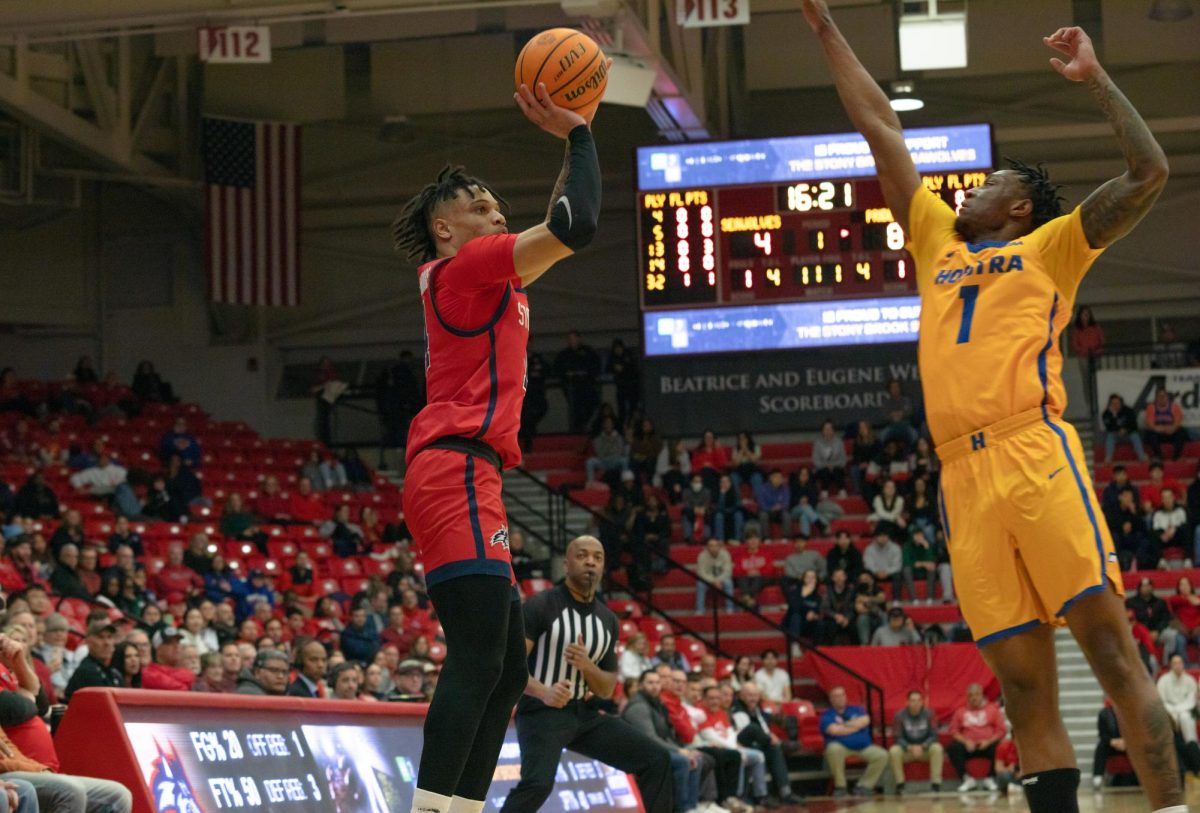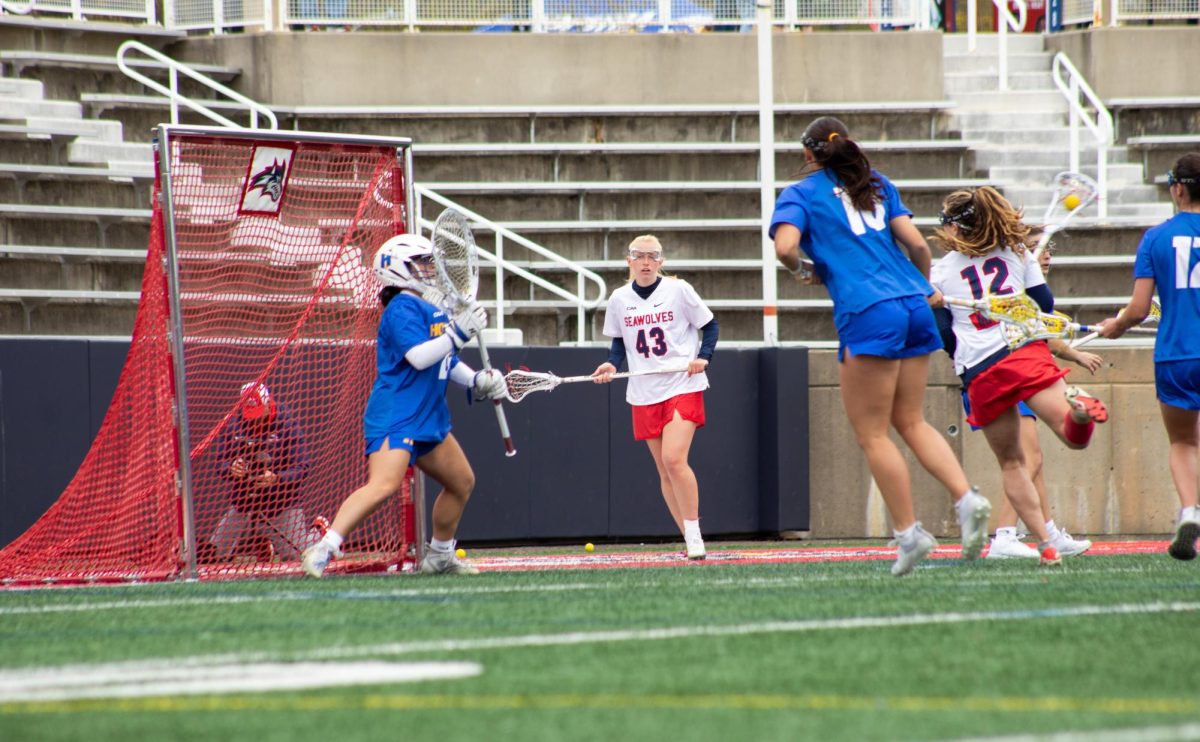
“That’s one of my favorite quotes,” Kameron Mitchell said as he pointed to an hourglass tattoo on his right arm with the words “time waits for no man” embedded with it.
Time has certainly not waited for the 6-foot-4-inch sophomore.
Just a year ago, Mitchell was struggling to find consistent playing time for the Seawolves. Today, he is a pivotal role player that not long ago led a charge to upset the No. 13 Washington Huskies.
In a month, Mitchell will be tasked with a major role in Stony Brook’s push towards its first NCAA Tournament berth.
“Coach calls me a veteran. Every time he says ‘you’re one of the veterans’ I’m like, ‘wow I’m only a sophomore.’ With our young team I kind of have to be a veteran, I have to teach some of these guys the ropes,” Mitchell said. “They haven’t really had the experience that I have.”
And to think, Mitchell very nearly did not end up at Stony Brook, or even playing basketball for that matter.
“I played football, basketball and baseball up until high school,” Mitchell said. “Then, my sophomore year in high school, I wasn’t growing, so my basketball coach kind of influenced me to give up football. I played quarterback so I was kind of too small. He encouraged me that I would be a better point guard than I would be a quarterback so that’s when I made that decision.”
This encouragement paid off for Mitchell, who dominated in his last two years of high school to the tune of 23.2 and 21.5 points a night for Mandarin High School in Jacksonville, Fla. Mitchell was “more of a facilitator” early in his high school career, but being given “the green light at all times” by his coach helped him develop the stroke that makes him so deadly today.
Mitchell originally committed to Wagner College, but after a major coaching change, Mitchell reopened his recruitment and immediately focused in on Stony Brook.
“Stony Brook was the school that was interested all along,” Mitchell said. “I always told [my high school coach,] I want to get away, I’ve been here too long, I’ve been here my whole life, so just want to do my own thing so that’s why I came here.”
Mitchell averaged just 8.4 minutes a night in his freshman year, having to adjust to the college game. Playing mostly point guard in high school, Mitchell’s ballhandling and playmaking did not translate well. The same goes for trying to stay in front of opposing point guards. Just under a quarter of Mitchell’s plays ended in a turnover in his rookie campaign.
“When I first came, I was hesitant, because I didn’t know what shots to take, how to read the offense, how to play,” Mitchell said.
Even in a forgettable first season, Mitchell’s future seemed bright. There were glimpses and what-ifs, but also a few things that stuck out as truly promising. For one, his ability to draw charges.
“I feel like I have a quick first step, so I’m pretty good at anticipating another person’s first step. If I feel my feet are planted and I’m in good position, I’ll just try to take one,” Mitchell said. “I’ve been taking charges my whole career, but here I really started to put that into my game because I needed to find my way on the court.”
Then, there was the emotion he brought to the floor. “It’s just natural. I’m a very competitive person. I’m a very, very competitive person,” Mitchell said. “When I feel like I contribute to a win or do something to get my team going I’m going to act on it and make them know, ‘yeah let’s go,’ try and get them going.”
Finally, there was his jumper, which connected on a solid 38.1 percent from downtown. “I try to get the ball on the shoulder in my shooting pocket and I try to make sure I follow through my wrist,” Mitchell said. “If I get the ball on my shoulder and I can get lined up with the basket I feel like it can go in, any shot I take.”
Coming into this season, Mitchell was a completely reinvented basketball player, moving over permanently to the wing spot to adding lots of muscle to having his head coach call him the team’s best perimeter defensive presence. However, Mitchell lost his starting position to freshman Bryan Sekunda 10 games into the season.
“I didn’t think anything of it,” Mitchell said. “I still had the same mindset going into every game, go in and play good defense, try and help my team.”
The change did wonders for Mitchell’s and Stony Brook’s game, however. The Seawolves are 10-5 since the switch after starting off with a 5-5 record. Mitchell’s defensive energy picked up and he was finally looking like the dependable “three-and-D” wing SBU needed him to be.
Then, he had the game of his life. After falling behind by as much as 16, Mitchell knocked down four threes on five tries in a wild Seawolves comeback to beat the previously unbeaten Washington Huskies, the program’s first win against a nationally-ranked opponent.
“After I hit that first three I was like, ‘alright, got to keep getting them off because I feel pretty good right now,’” Mitchell said. The game seemed to insert even more life into Mitchell’s steady ascension, and he agrees.
“It definitely put confidence in my shot, that’s for sure. After that, I felt like I could get four, five shots up a game, start shooting more,” Mitchell said.
Prior to the Huskies game, Mitchell attempted .76 two-point field goals and .68 free throws per half. Following the Washington trip, those numbers jumped to 1.7 and .72 respectively.
“Pikiell told me he wanted me to be more aggressive,” Mitchell said. “He’s noticed in practice that I can score at the rim pretty well, so he gave me the green light to go ahead and try and do that whenever I can.”
And that three-point shot of his? Well, Mitchell is 12th among the nation’s sophomores who have attempted at least 35 threes this season in three-point percentage at 46.5 percent. All while trying to remain the squad’s best perimeter defender. “Felt like he was kind of hyping me up a little bit. I would love to be labeled that,” Mitchell said. “Every time I go on the court I want to guard the other team’s best offensive player and try to limit their success. I’m going to try and live up to it.”























